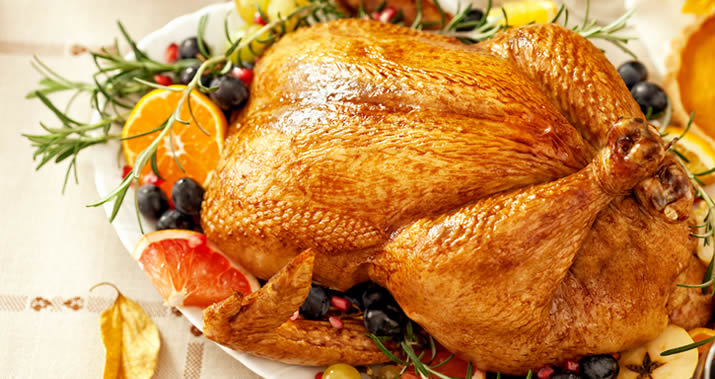
One of the best parts of the holiday season is gathering around the dinner table and indulging in all the roast turkey you can eat. Between crispy skin and juicy meat, what’s not to love? Fortunately, you can eat your fill of turkey and still maintain a healthy diet as long as you follow a few simple guidelines.
Skip the Fryer
Deep-fried turkey might be tasty, but it isn’t the healthiest or lowest calorie option. (Not to mention how complicated and dangerous frying an entire turkey can be!) While cooking turkey in oil might yield very juicy meat, it’s not the only way to get a tasty bird. Rub the outside and body cavity with a mixture of fresh rosemary, sage, thyme, and olive oil for meat that’s bursting with flavor and juiciness, without all of the extra fat from deep frying.
Brine and Butterfly
One old way to get browned skin and moist meat involves rubbing a stick of butter on the turkey before cooking. While it works, it also adds a lot of saturated fat and calories. You can get meat that’s even more moist and flavorful by brining the raw turkey, removing the backbone, and roasting it flat. The brining adds moisture, while butterflying the bird helps it cook through evenly — which means browned skin, and no dry, overcooked bits. For a simple brine, combine:
2 C dry white wine
5 C apple cider
1 C kosher salt
1/2 C sugar
6 sprigs fresh sage
3 bay leaves
6 sprigs fresh thyme
Enough water to cover turkey
Heat the apple cider, salt, and sugar in a sauce pot. When the salt and sugar have dissolved, add the other ingredients. Place the turkey in a vessel large enough to submerge it, and add the brine plus enough water to keep the turkey covered. Cover and refrigerate for up to two days before cooking.
Read the Label
The meat of many conventionally-farmed birds is injected with water and salt to give it extra moisture and weight, which drives up its price without giving you any real benefit. Look for low-sodium turkeys that don’t have salt added during processing, and make your own brine instead. Not only will it help you cut down on sodium (which means healthier blood pressure and less water weight), your taste buds will thank you.
Choose the Right Cuts
Not all turkey meat is equally healthful. While the difference isn’t a dramatic one, one ounce of boneless, skinless turkey breast will give you roughly 46 calories and 1 gram of fat, and one ounce of boneless, skinless thigh meat yields about 50 calories and 2 grams of fat. That said, dark meat does contain more riboflavin, thiamine, iron, zinc, and vitamin B. So, if you’re counting calories and grams of fat, opt for light meat over dark.
Remove the Skin
Turkey skin adds a lot of fat, which, in turn, piles on the calories. Consuming one turkey breast with skin will give you an extra 33 calories and 4 grams of fat versus eating one with the skin removed. Having dark meat with skin yields an extra 40 calories and 5 grams of fat. Skipping the skin won’t rob your turkey of flavor, but it will help you save calories.
Pair it with a Healthy Side Dish
Turkey itself is a pretty good source of lean protein, so the bulk of the holidays’ dietary damage tends to come from piling on calorie-dense side dishes. Fortunately, there are a ton of easy-to-make dishes that will still give you the flavors you want in a healthier, lower-calorie form. Try sautéing Brussels sprouts with a little bacon for a nutrient-packed, tasty side dish, or stuffing roast butternut squash with wild rice and herbs.
You can also roast and eat your sweet potatoes and other root vegetables with the skins on for added fiber, vitamins, and minerals. When choosing your side dishes, opt for ones that use as much of the vegetable as possible — skins contain loads of fiber, which helps increase satiety and reduce the impact of dietary fat on blood lipids.
A beautiful, browned, roasted turkey is the cornerstone of many holiday dinners this time of year. By using the right cooking methods, choosing low-fat cuts, and pairing your turkey with well-prepared side dishes, you can enjoy all of your favorite holiday flavors while eating a healthy diet and still reaching your weight loss goals.